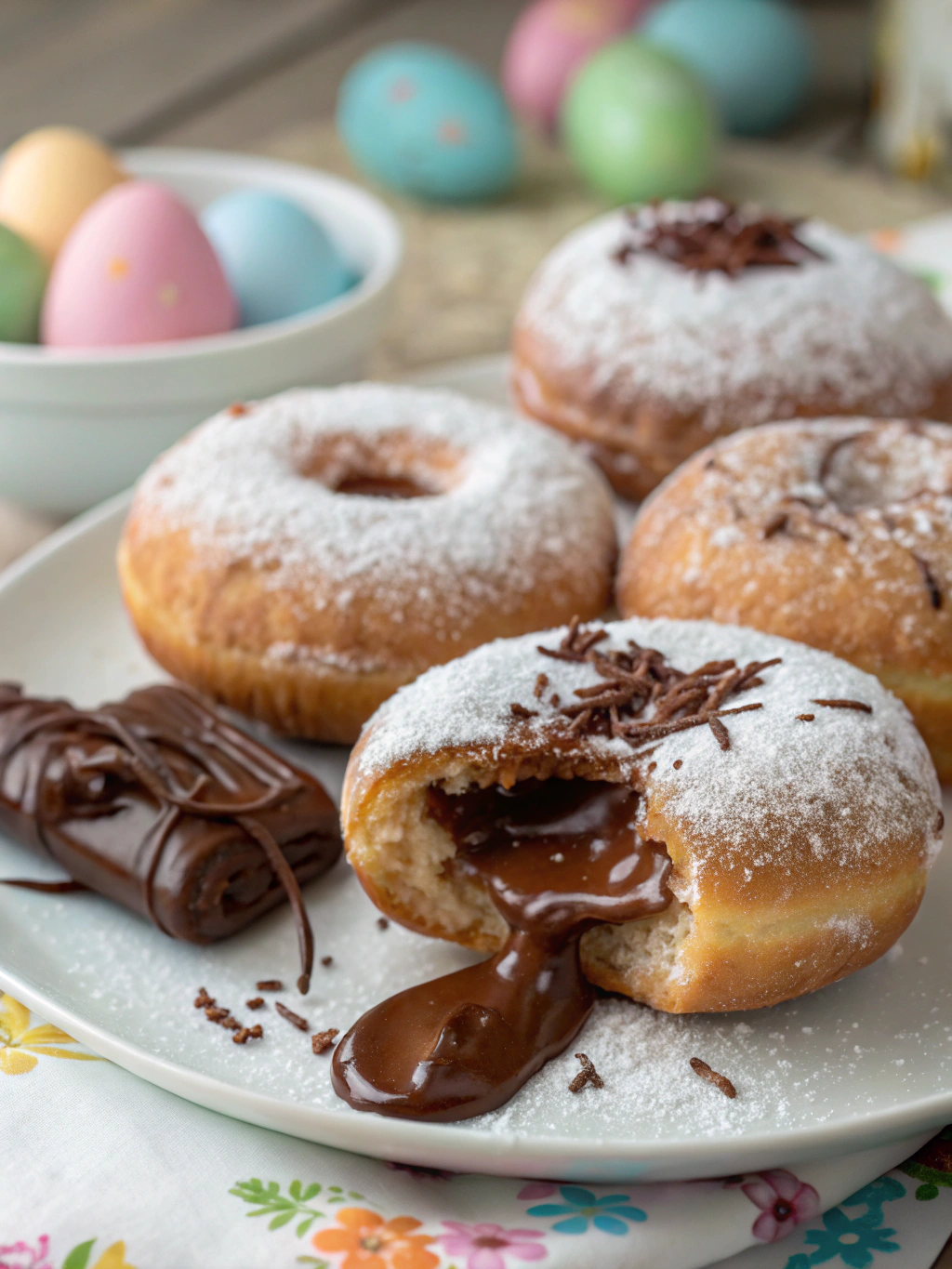Easter is the perfect time to indulge in something sweet, and Nutellava Donuts are the ultimate treat for any chocolate lover. These decadent donuts feature a soft, pillowy dough filled with rich, gooey Nutella that oozes out with every bite. Whether served for brunch, dessert, or an afternoon treat, these donuts bring a delightful combination of flavors that’s impossible to resist. Their crisp exterior, fluffy interior, and luscious filling make them a standout dessert that will impress guests and satisfy any sweet tooth.
What sets these Nutellava Donuts apart is their irresistible molten center. The contrast between the warm, golden-brown dough and the velvety, chocolate-hazelnut filling creates a symphony of textures and tastes. Each bite delivers a perfect balance of sweetness and richness, making these donuts a memorable addition to your Easter spread. Plus, they’re surprisingly easy to make, whether you choose to fry or bake them.
The beauty of this recipe is that you can customize the donuts to your liking. While Nutella is the star of the show, you can experiment with different fillings such as raspberry jam, peanut butter, or even caramel. A dusting of powdered sugar or a drizzle of melted chocolate on top adds an extra layer of indulgence, making these donuts as visually appealing as they are delicious.
Nutellava Donuts also make a fantastic interactive dessert activity for family gatherings. Kids and adults alike will love filling the donuts and watching the Nutella ooze out as they take their first bite. It’s a fun and rewarding kitchen project that brings everyone together, adding a touch of sweetness to your Easter celebrations.
These donuts are best enjoyed fresh, but they can also be made ahead of time and reheated for a warm, gooey treat. Whether you’re serving them for breakfast, brunch, or as an after-dinner dessert, they’re sure to become a new family favorite. Their irresistible texture and rich filling make them a show-stopping addition to any holiday spread.
If you’re looking to add a gourmet touch to your Easter table, Nutellava Donuts are the way to go. Their sophisticated flavor profile and stunning presentation make them a standout choice that will leave a lasting impression on your guests. Pair them with a cup of coffee or hot cocoa for an extra cozy experience.
Another reason to love these donuts is their versatility. You can make them using a traditional fried dough method for a classic donut texture, or opt for a baked version if you prefer a lighter option. Either way, the result is a batch of golden, Nutella-filled treats that will have everyone asking for seconds.
Nutellava Donuts are also perfect for gifting. Package them in a festive box or clear treat bags tied with pastel ribbons, and you’ve got a thoughtful and delicious Easter gift. These homemade goodies show your loved ones just how much you care, while adding a personal touch to your holiday celebrations.
No matter how you choose to enjoy them, Nutellava Donuts are guaranteed to be a hit. Their rich, molten center and light, fluffy dough make them an unforgettable treat that’s perfect for Easter and beyond. So grab your ingredients and get ready to indulge in the best homemade donuts you’ve ever had!

Servings
- Yield: 12 donuts
- Serving Size: 1 donut
Time
- Prep Time: 30 minutes
- Rise Time: 1 hour
- Cook Time: 5 minutes
- Total Time: 1 hour 35 minutes
Ingredients
For the Dough:
- 2 1/4 teaspoons active dry yeast
- 1/2 cup warm milk (110°F)
- 3 tablespoons granulated sugar
- 2 large eggs
- 3 tablespoons unsalted butter, melted
- 2 3/4 cups all-purpose flour
- 1/2 teaspoon salt
- Oil for frying (if frying)
For the Filling:
- 1 cup Nutella
For Topping:
- Powdered sugar (optional)
- Melted chocolate for drizzling (optional)
Instructions
- Activate the Yeast:
- In a small bowl, combine warm milk, sugar, and yeast.
- Let sit for 5-10 minutes until frothy.
- Prepare the Dough:
- In a large mixing bowl, combine the yeast mixture, eggs, melted butter, flour, and salt.
- Mix until a soft dough forms.
- Knead and Rise:
- Knead the dough on a lightly floured surface for about 8 minutes until smooth and elastic.
- Place the dough in a greased bowl, cover, and let rise for 1 hour or until doubled in size.
- Shape the Donuts:
- Roll out the dough to 1/2-inch thickness.
- Use a round cutter to cut out 3-inch circles.
- Fry or Bake:
- Frying: Heat oil in a deep fryer or pot to 350°F.
- Fry donuts in batches for 1-2 minutes per side until golden brown.
- Baking: Preheat oven to 375°F. Place donuts on a parchment-lined baking sheet and bake for 10-12 minutes until golden.
- Fill with Nutella:
- Once cooled, use a piping bag fitted with a small tip to fill each donut with Nutella.
- Add Toppings:
- Dust with powdered sugar or drizzle with melted chocolate, if desired.
- Serve and Enjoy:
- Serve warm for the best gooey Nutella experience.
Tips
- For a richer dough, use whole milk and an extra egg yolk.
- Use a candy thermometer to monitor the oil temperature while frying.
- For a lighter version, bake the donuts instead of frying.
- Fill the donuts while they’re slightly warm for easier piping.
- Store leftovers in an airtight container and reheat for 10-15 seconds in the microwave.
Summary
Nutellava Donuts are the ultimate indulgence for Easter, featuring a soft, fluffy dough filled with rich, molten Nutella. Whether fried or baked, these donuts are easy to make and perfect for sharing with family and friends. Their irresistible flavor and gooey center make them a standout addition to any Easter celebration.

